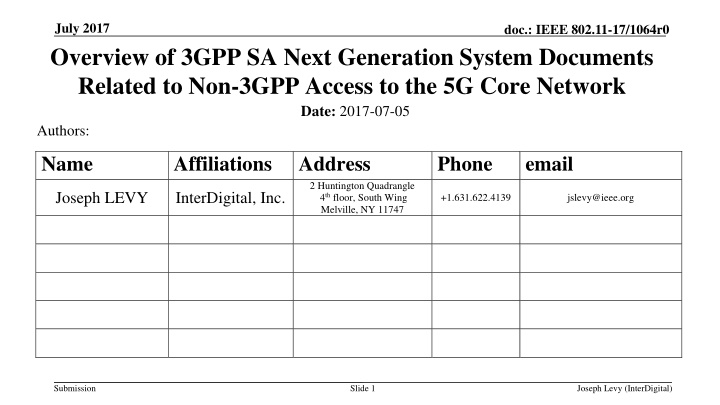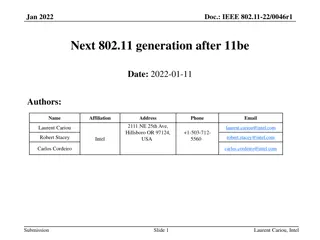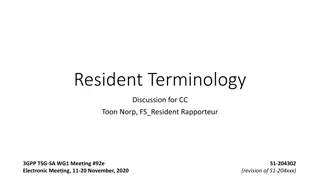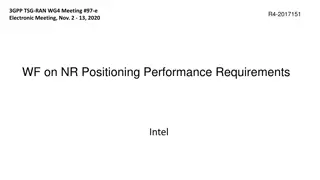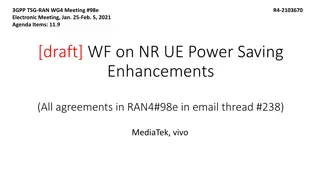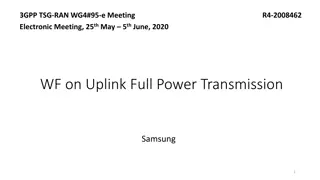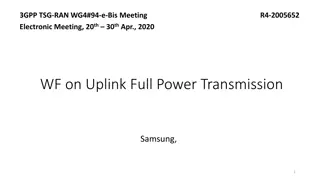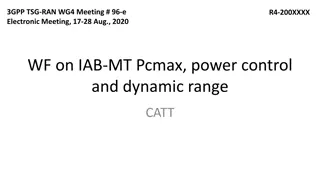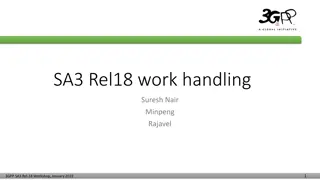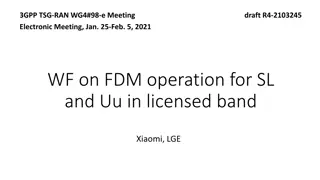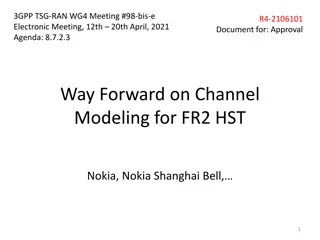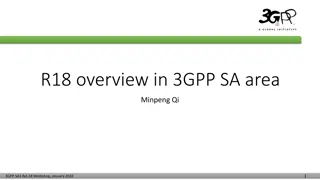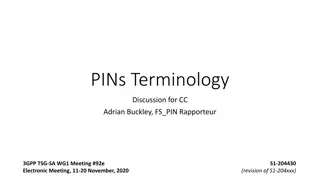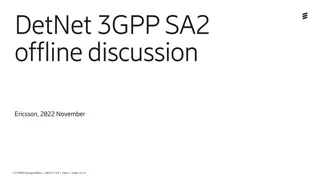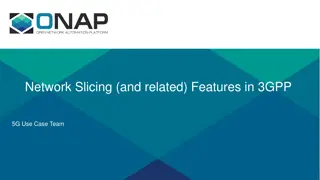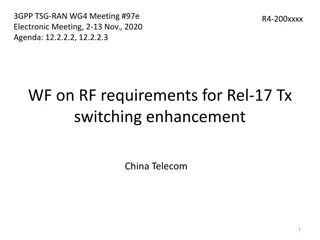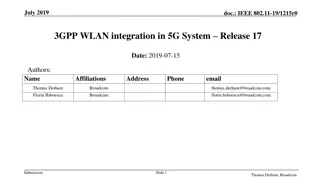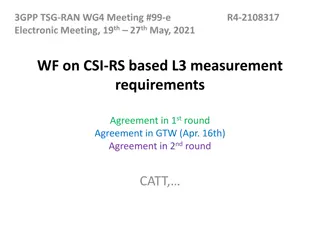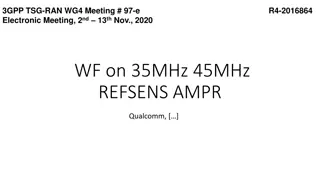Overview of 3GPP SA Next Generation System Documents
This document provides an overview of various 3GPP SA TSG Next Generation System documents, including completed and ongoing studies related to non-3GPP access to the 5G core network. It covers topics such as system architecture, security aspects, and access traffic steering in the context of the evolving 5G system architecture.
Download Presentation

Please find below an Image/Link to download the presentation.
The content on the website is provided AS IS for your information and personal use only. It may not be sold, licensed, or shared on other websites without obtaining consent from the author.If you encounter any issues during the download, it is possible that the publisher has removed the file from their server.
You are allowed to download the files provided on this website for personal or commercial use, subject to the condition that they are used lawfully. All files are the property of their respective owners.
The content on the website is provided AS IS for your information and personal use only. It may not be sold, licensed, or shared on other websites without obtaining consent from the author.
E N D
Presentation Transcript
July 2017 doc.: IEEE 802.11-17/1064r0 Overview of 3GPP SA Next Generation System Documents Related to Non-3GPP Access to the 5G Core Network Date: 2017-07-05 Authors: Name Affiliations Address 2 Huntington Quadrangle 4th floor, South Wing Melville, NY 11747 Phone email Joseph LEVY InterDigital, Inc. +1.631.622.4139 jslevy@ieee.org Submission Slide 1 Joseph Levy (InterDigital)
July 2017 doc.: IEEE 802.11-17/1064r0 Abstract This document provides an overview of several 3GPP SA TSG Next Generation System documents: Completed documents: 3GPP TR 23.799 Study on Architecture for Next Generation System 3GPP TR 33.899 Study on the Security Aspects of the Next Generation System Documents in development: 3GPP TS 23.501 System Architecture for the 5G System (Stage 2), companion to TS 23.502 And The 3GPP Study Item in progress: Access Traffic Steering, Switch, and Splitting support in the 5G system architecture (SP-170411) Submission Slide 2 Joseph Levy (InterDigital)
July 2017 doc.: IEEE 802.11-17/1064r0 Contents 1. Completed documents: 3GPP TR 23.799 Study on Architecture for Next Generation System 3GPP TR 33.899 Study on the Security Aspects of the Next Generation System Documents in development: 3GPP TS 23.501 System Architecture for the 5G System (Stage 2), companion to TS 23.502 Note: 3GPP TS 23.502 Procedures for the 5G System (Stage 2), companion to TS 23.501 and 3GPP TS 33.501 Security Architecture and Procedure for the 5G System currently contain minimal Non-3GPP access information. 3GPP Study Item in progress: Access Traffic Steering, Switch, and Splitting support in the 5G system architecture (SP-170411) 2. 3. Submission Slide 3 Joseph Levy (InterDigital)
July 2017 doc.: IEEE 802.11-17/1064r0 3GPP TR 23.799 Study on Architecture for Next Generation System 1/14 Architectural Overview (only WLAN related items included below) [1]: 1. Support the new RAT(s), the Evolved E-UTRA, and non-3GPP access types. GERAN and UTRAN are not supported: As part of non- 3GPP access types, WLAN access (including "untrusted WLAN" according to the meaning defined in pre Rel. 14 for the term "untrusted") and Fixed access shall be supported. 2. Support unified authentication framework for different access systems. 3. Support multiple simultaneous connections of an UE via multiple access technologies. 4. Support a separation of Control plane and User plane functions. 5. Support transmission of IP packets, non-IP PDUs and Ethernet frames. (assumes a p2p link). 7 Efficiently support different levels of UE mobility (including stationary UE)/service continuity. 8 Support services that have different latency requirements between the UE and the Data Network. 9 Minimize the signalling (and delay) required to start the traffic exchange between the UE and the Data Network Submission Slide 4 Joseph Levy (InterDigital)
July 2017 doc.: IEEE 802.11-17/1064r0 3GPP TR 23.799 Study on Architecture for Next Generation System 2/14 Architectural Overview (only WLAN related items included below) [1] (cont.): 10. Efficient network support for a large number of UEs in periods without data traffic. 11. Support network sharing. 12. Support roaming: 13. Support broadcast services. 14. Minimize energy consumption in the overall network operation. 15. Support critical communications, including mission-critical communications. 16. Support regulatory requirements for Lawful Intercept. 17. Support a flexible information model with relationships between user related managed data, and with a level of abstraction sufficient to be independent of any specific protocols. 18. Support for location services as per the related service requirements and in alignment with NR RAN TR 38.913 [10]. 19. Support regulatory requirements for Public Warning System (PWS), e.g. ETWS, CMAS, KPAS Slide 5 Submission Joseph Levy (InterDigital)
July 2017 doc.: IEEE 802.11-17/1064r0 3GPP TR 23.799 Study on Architecture for Next Generation System 3/14 Initial High Level Architectural View [1]: NextGen UE (R)AN NG2 Data network NG6 NextGen NextGen Core NG3 NG2: RP CP between NG AN and NG Core, NG3: RP UP between NG AN and NG Core, NG1: RP CP NG UE and NG Core, NG6 RP between NG Core and the data network. Architectural Principles: The UE may be attached to the network without having an established session for data transmission. The number of reference points between the UE and the NextGen Core Network for the control plane over a single RAN should be minimized, independently of the functional composition of the control plane CN functionality. Submission Slide 6 Joseph Levy (InterDigital)
July 2017 3GPP TR 23.799 Study on Architecture for Next Generation System 4/14 doc.: IEEE 802.11-17/1064r0 This Technical Report discusses 22 Key Issues [1]: 12. Security framework 13. Broadcast/Multicast Capabilities 14. Support for Off-Network Communication 15. NextGen core support for IMS 16. 3GPP system aspects to support the connectivity of remote UEs via relay UEs 17. 3GPP architecture impacts to support network discovery and 18. Interworking and Migration 19. Architecture impacts when using virtual environments 20. Traffic Steering, Switching and Splitting between 3GPP and non-3GPP Accesses 21. Minimal connectivity within extreme rural deployments 22. Support of "5G connectivity via satellite" use case 1. 2. 3. 4. 5. 6. Support of network slicing QoS framework Mobility management framework Session management Void Support for session and service continuity and efficient user plane path Network function granularity and interactions between them Next Generation core and access - functional division and interface 3GPP architecture impacts to support network capability exposure and context information awareness 10. Policy Framework 11. Charging 7. 8. 9. Submission Slide 7 Joseph Levy (InterDigital)
July 2017 doc.: IEEE 802.11-17/1064r0 3GPP TR 23.799 Study on Architecture for Next Generation System 5/14 Key issue 20: Traffic Steering, Switching and Splitting between 3GPP and non-3GPP Accesses [1] Investigating: 1. How the NextGen Core network and the NextGen UE can support access traffic steering (as defined in clause 3.1) between 3GPP and non-3GPP accesses. 2. How the NextGen Core network and the NextGen UE can support access traffic switching (as defined in clause 3.1) between 3GPP and non-3GPP accesses. This includes the conditions that can trigger the switching of a data flow to a new access. 3. How and if the NextGen Core network and the NextGen UE can support access traffic splitting (as defined in clause 3.1) between 3GPP and non-3GPP accesses. This includes the conditions that can trigger the splitting of a data flow across multiple accesses. 4. How the access traffic steering, switching and splitting (ATSSS) can be taken into account by the charging framework (considered in Key Issue 11) in order e.g. to enable the network operator to differentiate charging for data traffic that is switched and/or split between 3GPP and non-3GPP accesses. It is clarified that this key issue will not address the charging framework but it will only consider what information needs to be provided to the charging framework in order to charge traffic that is switched and/or split between 3GPP and non-3GPP accesses. Note: Potential policies provided to the UE for access traffic steering, switching and splitting (ATSSS), if any, will be defined under the key issue on Policy Framework. This key issue is restricted only to ATSSS procedures applied in the NextGen core network. Similar procedures that may be applied in the NextGen RAN are outside the scope of this key issue. The procedures for access traffic steering, switching and splitting take place after the session management procedures are executed, i.e. after PDU sessions are established over 3GPP and non-3GPP accesses. Submission Slide 8 Joseph Levy (InterDigital)
July 2017 doc.: IEEE 802.11-17/1064r0 3GPP TR 23.799 Study on Architecture for Next Generation System 6/14 Solutions for Key Issue 20: 3GPP architecture impacts to support access traffic steering and switching (note: this solution does not address splitting aspects) [1]: Non-Roaming CP-CN? ATSS? function UE? ATSS? function CP-CN? Policy? function CN AN? UE CP-CN ATSS function Roaming CP-CN Policy function CN HPLMN VPLMN UE ATSS function CP-CN ATSS function CP-CN Policy function UE AN CN Submission Slide 9 Joseph Levy (InterDigital)
July 2017 doc.: IEEE 802.11-17/1064r0 3GPP TR 23.799 Study on Architecture for Next Generation System 7/14 Solutions for Key Issue 20: 3GPP architecture impacts to support access traffic steering and switching (note: this solution does not address splitting aspects) [1]: New data flow by UE CP-CN Policy CP-CN CP-UP DN CP-CN ATSS UE AN 1 AN 2 0. UE is provisioned with access traffic steering and switching info 1. a new data flow for Service X is initiated at the UE 2a. Reference signals for AN 1 2b. Reference signals for AN 2 3. UE ATSS function selects AN 2 4. Connectivity setup 5. data flow establishment via AN 2 CP-CN CP-UP DN CP-CN ATSS UE CP-CN Policy AN 1 AN 2 Steering DL data flow by the network dual radio- capable UE 1. DL data for Service X towards UE 2. Request to select access for traffic steering (Service X, UE) 3. CP-CN ATSS function selects AN 1 4. Traffic steering response (access #1) 5. Paging 6. Connectivity setup 7. data flow establishment via AN 1 Submission Slide 10 Joseph Levy (InterDigital)
July 2017 doc.: IEEE 802.11-17/1064r0 3GPP TR 23.799 Study on Architecture for Next Generation System 8/14 Solutions for Key Issue 20: 3GPP architecture impacts to support access traffic steering and switching (note: this solution does not address splitting aspects) [1]: Switching of an ongoing data flow by the UE CP-CN Policy CP-CN CP-UP DN CP-CN ATSS UE AN 1 AN 2 0. UE is provisioned with access traffic steering and switching info 1. Ongoing data flow for Service X on access #1 via AN 1 2a. Reference signals for AN 1 2b. Reference signals for AN 2 3. Mobility context of UE changes (e.g user gets into his car and starts driving away from home AP) 4. UE ATSS function decides to switch data flow to access #2 via AN 2 5. Connectivity setup 6. data flow establishment on access # 2 via AN 2 7. Ongoing data flow for Service X on access #1 via AN 1 is suspended Submission Slide 11 Joseph Levy (InterDigital)
July 2017 doc.: IEEE 802.11-17/1064r0 3GPP TR 23.799 Study on Architecture for Next Generation System 9/14 Solutions for Key Issue 20: Solution based on ATSSS Function [1]: Architecture NextGen Core Network ATSSS (Access Traffic Steering, Switching and Splitting) NGa NGap ATSSS Function Policy Function NGpu NGau UE Trusted WLAN NG3 UP Functions NG3 NextGen RAN Submission Slide 12 Joseph Levy (InterDigital)
July 2017 doc.: IEEE 802.11-17/1064r0 3GPP TR 23.799 Study on Architecture for Next Generation System 10/14 Solutions for Key Issue 20: Solution based on ATSSS Function [1]: UE IP-2 IP-1 WLAN 3GPP High-level concept of operation UE establishes a Control Connection with ATSSS Function (via NGa) UE may receive new/updated Steering rules ATSSS Function UE starts a new flow UE decides to use 3GPP or WLAN based on configured Steering rules Traffic routed via ATSSS Function can later be switched/split between 3GPP & WLAN access UE starts the flow over 3GPP (e.g. starts a new TCP connection) Traffic not routed via ATSSS Function cannot be switched/split between 3GPP & WLAN access UP Functions determine to steer the flow via ATSSS Function or not ATSSS Function decides (based on switching/splitting rules) to (1) switch the flow to WLAN or (2) split the flow across 3GPP and WLAN access (via Control Connection) Add_Access (Session Ref, mode=switch, active=WLAN) UP Functions steer the traffic of this leg to ATSSS Function UE creates an access leg over WLAN (e.g. starts a new TCP connection over WLAN) UE associates the two access legs of the flow. Sends UL traffic of flow either in the active access (in case of switch mode) or in both accesses (in case of split mode). ATSSS Function associates the two access legs of the flow. Sends DL traffic of flow either in the active access (in case of switch mode) or in both accesses (in case of split mode). Both access legs exist even when one is active (carries traffic) and the other is standby (does not carry traffic). Submission Slide 13 Joseph Levy (InterDigital)
July 2017 doc.: IEEE 802.11-17/1064r0 3GPP TR 23.799 Study on Architecture for Next Generation System 11/14 Solutions for Key Issue 20: Solution based on ATSSS Function [1]: App-1 App-2 NextGen CN Protocol Architecture UE ATSSS Server ATSSS Client Control Connection (NGa) SSF SSF ATSSS Function TCP/ UDP TCP/ UDP IP IP NG3 Private IP Public IP WLAN 3GPP NextGen RAN Remote Host NGwu Trusted WLAN Submission Slide 14 Joseph Levy (InterDigital)
July 2017 doc.: IEEE 802.11-17/1064r0 3GPP TR 23.799 Study on Architecture for Next Generation System 12/14 Solutions for Key Issue 20: Solution based on ATSSS Function [1]: App-1 App-1 Modes of SSF Operation (UE side) TCP/UDP flow TCP/UDP flow ATSSS Client ATSSS Client SSF: Switching/ Splitting Function SSF SSF Active Active Standby Active TCP/ UDP IP TCP/ UDP IP WLAN 3GPP WLAN 3GPP Switch mode Split mode Submission Slide 15 Joseph Levy (InterDigital)
July 2017 doc.: IEEE 802.11-17/1064r0 3GPP TR 23.799 Study on Architecture for Next Generation System 13/14 Solutions for Key Issue 20: Solution based on ATSSS Function [1]: ATSSS Function IP-u Policy Function UE IP-2 IP-1 IP-c IP-e Switching the traffic of a TCP flow between 3GPP and WLAN access WLAN 3GPP 1 Control Connection + Authentication 1 ADD_ADDR (IP-1, 3GPP), (IP-2, WLAN) 1 Get ATSSS policy 1 Updated/new Steering rules Remote Host 2 UE starts video streaming 3 TCP Connection Src=IP-1, Dst=remote host, Keys 3 TCP Connection 3 Relay 4 HTTP GET 4 HTTP GET 200 OK . . . 200 OK . . . 5 Decides to move traffic to WLAN access 5 ADD_ACCESS Session Ref, mode=switch, active=WLAN 6 TCP Connection Src=IP-2, Dst=remote host, Token 6 Join the new TCP connection with the existing TCP connection 6 Join the new TCP connection with an existing TCP connection 7 All streaming traffic on WLAN access . . . . . . 8 Decides to move traffic to 3GPP access 8 CHANGE_ACCESS Session Ref, mode=switch, active=3GPP 9 All streaming traffic on 3GPP access . . . . . . Submission Slide 16 Joseph Levy (InterDigital)
July 2017 doc.: IEEE 802.11-17/1064r0 3GPP TR 23.799 Study on Architecture for Next Generation System 14/14 Solutions for Key Issue 20: Solution based on ATSSS Function [1]: ATSSS Function IP-u UE IP-2 IP-1 IP-c IP-e Splitting the traffic of a TCP flow between 3GPP and WLAN access WLAN 3GPP 1 Control Connection Remote Host 2 UE starts video streaming 3 TCP Connection Src=IP-1, Dst=remote host, Keys 3 TCP Connection 3 Relay 4 HTTP GET 4 HTTP GET 200 OK . . . 200 OK . . . 5 Decides to split traffic on both 3GPP & WLAN accesses 5 ADD_ACCESS Session Ref, mode=split 6 TCP Connection Src=IP-2, Dst=remote host, Token 6 Join the new TCP connection with the existing TCP connection 6 Join the new TCP connection with an existing TCP connection 7 All streaming traffic on both accesses . . . . . . Split / Combine Split / Combine . . . Submission Slide 17 Joseph Levy (InterDigital)
July 2017 doc.: IEEE 802.11-17/1064r0 3GPP TR 33.899 Study on the Security Aspects of the Next Generation System #1.27: Authentication and Key Agreement procedure for untrusted non-3GPP Access [2]: General architecture NG1 NextGen Core NWu CP NG2 SDM Standalone UnTrusted Non-3GPP access Functions UE N3IWF Y1 NG3 UP Functions Submission Slide 18 Joseph Levy (InterDigital)
July 2017 doc.: IEEE 802.11-17/1064r0 3GPP TR 33.899 Study on the Security Aspects of the Next Generation System #1.27: Authentication and Key Agreement procedure for untrusted non-3GPP Access [2]: High-level Control Plane Procedure for Untrusted non-3GPP Access EAP Authenticator EAP Server UE AUSF N3IWF AMF 4a. NAS messages via IPSec SA 4b. NAS messages over N1 Interface NAS messages NAS messages Submission Slide 19 Joseph Levy (InterDigital)
July 2017 doc.: IEEE 802.11-17/1064r0 3GPP TR 33.899 Study on the Security Aspects of the Next Generation System #1.28: Authentication and Key agreement procedure for NextGen architecture with stand- alone non-3GPP access [2]: High-level 3GPP EAP-AKA flow for Non-3GPP Access CP UE N3ASF function Attach Request Attach Request Authentication Request/Response ... Attach Complete IPsec Tunnel Submission Slide 20 Joseph Levy (InterDigital)
July 2017 doc.: IEEE 802.11-17/1064r0 3GPP TS 23.501 System Architecture for the 5G System (Stage 2) Currently 23.501 supports [3]: 1. Connectivity of the UE only via non-3GPP access networks, e.g. WLAN access. 2. Non-3GPP access is standalone untrusted non-3GGP access 3. A UE access the 5G Core Network supports NAS signaling using N1 reference point 4. Non-3GPP access networks shall be connected via a Non-3GPP InterWorking Function (N3IWF). 5. A UE shall establish an IPSec tunnel with the N3IWF, the UE shall be authenticated by and attached to the 5G Core Network during the IPSec tunnel establishment procedure. 6. N1 NAS signaling over standalone non-3GPP accesses shall be protected with the same security mechanism applied for N1 over 3GPP access. Submission Slide 21 Joseph Levy (InterDigital)
July 2017 doc.: IEEE 802.11-17/1064r0 3GPP TS 23.501 System Architecture for the 5G System (Stage 2) Non-roaming architecture for 5G Core Network with Non-3GPP access [3]: AMF: Access and Mobility Management Function SFM: Session Management Function N3IWF: Non-3GPP InterWorking Function UPF: User Plane Function N2 N11 3GPP Access AMF SMF N3 N2 N4 N1 Data Network N3IWF UPF N3 N6 HPLMN NWu Y2 N1 Non-3GPP Networks Untrusted Non- 3GPP Access UE Y1 Submission Slide 22 Joseph Levy (InterDigital)
July 2017 doc.: IEEE 802.11-17/1064r0 3GPP TS 23.501 System Architecture for the 5G System (Stage 2) Roaming architecture for LBO for 5G Core Network with Non-3GPP access N3IWF in the VPLMN [3]: N2 N11 3GPP Access AMF SMF N3 N2 N4 N1 Data Network N3IWF UPF N3 N6 VPLMN NWu Y2 N1 Non-3GPP Networks Untrusted Non- 3GPP Access UE Y1 Submission Slide 23 Joseph Levy (InterDigital)
July 2017 doc.: IEEE 802.11-17/1064r0 3GPP TS 23.501 System Architecture for the 5G System (Stage 2) Home-routed Roaming architecture for 5G Core Network with Non-3GPP access N3IWF in a different the VPLMN from the 3GPP access [3]: VPLMN1 HPLMN N11 vSMF AMF N2 3GPP Access N4 N3 UPF N16 N1 hSMF N9 Non-3GPP Networks N4 Y1 Untrusted Non- 3GPP Access UE N16 Data Network UPF N1 Y2 NWu N9 N3 VPLMN2 N3IWF UPF N2 N4 N11 AMF vSMF Submission Slide 24 Joseph Levy (InterDigital)
July 2017 doc.: IEEE 802.11-17/1064r0 3GPP Study Item in progress: Access Traffic Steering, Switch, and Splitting support in the 5G system architecture (SP-170411) [6] Justification Today, non-3GPP access is a vital companion access infrastructure for mobile networks that can help mobile operators deal with the explosive rate of growth in network traffic. Non-3GPP access such as Wi-Fi can relieve the pressure on the mobile network and can offer fast indoor data connections. Increasingly, many operators are seeking ways to balance data traffic between mobile networks and non-3GPP access in a way that is transparent to users and reduces mobile network congestion. This can be achieved by not only steering traffic from the mobile network onto non-3GPP access, but also to switch or split traffic in a managed way For UEs that can be simultaneously connected to both 3GPP access and non-3GPP access, the 5G system should be able to take advantage of these multiple accesses in a way that improves the user experience, optimizes the traffic distribution across various accesses, enables the provision of new high-data-rate services, etc. Note: Access Traffic Steering, Switching and Splitting is: ATSSS Submission Slide 25 Joseph Levy (InterDigital)
July 2017 doc.: IEEE 802.11-17/1064r0 3GPP Study Item in progress: Access Traffic Steering, Switch, and Splitting support in the 5G system architecture (SP-170411) [6] (cont.) Objective - How the 5G Core network and the 5G UE can support multi-access traffic steering between 3GPP and non-3GPP accesses. - How the 5G Core network and the 5G UE can support multi-access traffic switching between 3GPP and non-3GPP accesses. This includes the conditions that can trigger the switching of data traffic to a new access type. - How the 5G Core network and the 5G UE can support multi-access traffic splitting between 3GPP and non-3GPP accesses. This includes the conditions that can trigger the splitting of data traffic across multiple accesses. - How the multi-access traffic steering, switching and splitting (ATSSS) can be taken into account by the charging framework in order e.g. to enable the network operator to differentiate charging for data traffic that is switched and/or split between 3GPP and non-3GPP accesses. - How the 5G core network can support multi-access PDU sessions, i.e. PDU sessions whose traffic can be sent over 3GPP access, or over NON-3GPP access, or both. Work Plan: Approved: June 2017, Target Completion: Sept 2018 Submission Slide 26 Joseph Levy (InterDigital)
July 2017 doc.: IEEE 802.11-17/1064r0 References 1. 2. 3. 4. 5. 6. 3GPP TR 23.799 Study on Architecture for Next Generation System 3GPP TR 33.899 Study on the Security Aspects of the Next Generation System 3GPP TS 23.501 System Architecture for the 5G System (Stage 2), companion to TS 23.502 3GPP TS 23.502 Procedures for the 5G System (Stage 2), companion to TS 23.501 3GPP TS 33.501 Security Architecture and Procedure for the 5G System 3GPP Work Item Description for: Study on Access Traffic Steering, Switch, and Splitting support in the 5G system architecture (SP-170411) Submission Slide 27 Joseph Levy (InterDigital)
